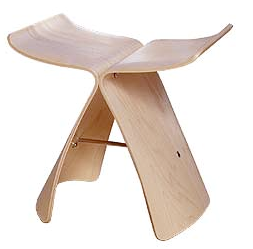Design Classics
Butterfly Stool, 1956
Designer: Sori Yanagi
Manufacturer: Tendo Company Tokyo

Sori Yanagi is one of the masters of Japanese industrial design. Born is 1915, he studied painting and worked as an architect. It was through these connections that he met and later became an advisor in the Tokyo office of the French designer Charlotte Perriand, who designed much of the furniture credited to architect Le Corbusier. Yanagi's prolific output spans an astounding range of products from cars, medical equipment, bridges, public seating and signage to housewares and furniture. In 1950, he was a co-founder of the Japan Industrial Design Foundation, the most important design organization in Japan. In 1977 became the director of the Japan Folk Crafts Museum.
WHAT
The Butterfly Stool is made of two identical pieces of moulded plywood held together with a brass rod. Although he worked with Madame Perriand, Yanagi was never fully won over by the hard-edged industrial-inspired aesthetic of the International Style. Yanagi once said that he preferred “gentle and rounded forms because they radiate human warmth.” Design historians Kathryn Hiesinger and George Marcus observe his interest more as a “dialogue with tradition ... employing modern materials and manufacturing process ... while exploiting vernacular forms and traditional styles.” While the stool is not a traditional Japanese interior object, the matchbook wood grain, the exuberant curves which recall Japanese architecture and the floating appearance elegantly combine eastern and western idioms. The stool won a gold medal at the Milan Trienale in 1957 and is in the collection of the Museum of Modern Art in New York, the San Francisco Museum of Modern Art and the Metropolitan Museum.
WHY
The Butterfly Stool holds an honoured place in the pantheon of moulded plywood furniture, along with examples by Charles and Ray Eames, Alvar Aalto and George Nelson. What Yanagi brings to the technique of forming wood is the eastern stylistic references compared by one critic to “calligraphy.” While the stool is indeed functional, there is also a spiritual side to Yanagi's design. He declared that “basic concepts and beautiful forms do not come from the drawing board alone.” The stool's grace and lightness belie its hardiness as a place to perch (but not for too long) and a piece of design poetry.
National Post, June 8, 2006.
